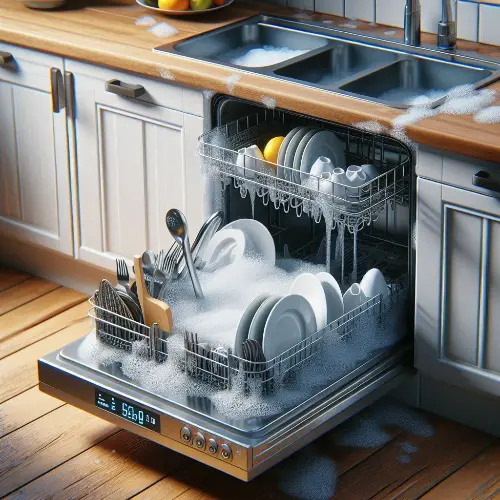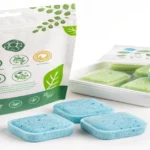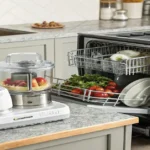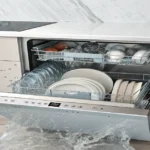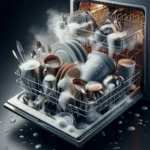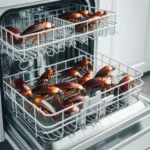GE Dishwasher Model # PDWT580R10SS water is not draining out entirely? This is just as well because why this model of LG gets the drain in the tub so wrong, we don’t know.
Thankfully, most drainage problems can be easily fixed with some work and troubleshooting.
So, if you go to turn the Dishwasher on and notice your GE dishwasher washer is not draining, read more below about what it could be and how you can fix it.
Why is Proper Draining Important in a Dishwasher?
But, before covering the troubleshooting part, I need to explain why properly draining is essential for every Dishwasher.
A dishwasher is a machine used to clean dirty dishes by hot water washing & sometimes sterilizing and rinsing with detergent to remove dirt, grime or residue from most ingredients.
No Drain If water does not drain at the end of the wash or rinse cycles, your dishes will never be cleaned.
When water sits too long in a trap, it will let off an odor so foul that your Dishwasher could end up with leaks and mold inside.
This will keep your dishes cleaner with excellent drying and control of water damage inside the unit.
Common Causes of Draining Issues in GE Dishwasher Model PDWT580R10SS
There are a few common culprits that prevent water from draining correctly in your GE dishwasher:
Clogged or Kinked Drain Hose
One common reason for draining is that your Dishwasher is not emptying the water into a clogged or blocked drain hose.
During this time, cookies and dirt accumulate. In addition, the hose, if kinked behind or under the Dishwasher, prevents water from flowing properly.
Faulty Drain Pump
When the water has to be removed from your system, it is done by that component which we know as drain pump and this role in an easy way push out through drain hose.
A faulty pump will prevent water from being pumped out of the Dishwasher properly at the end or after a cycle. It could be the pump is plugged or that your motor has kicked.
Clogged Impeller
The impeller is attached to a moveable component in the drain pump’s interior; it has no bearings upon rotating.
It helps push water through. Much like the drain hose, this can also be stopped by debris.
If you have a clogged impeller, it will mean that the water is moving slower, or perhaps at all, for coins and debris to flow down.
Failed Water Inlet Valve
This is where the inlet valve controls the water flow that enters your dishwasher tub.
If this valve goes wrong, it can allow too much water in the tub and flood over or prevent enough of a drain out.
Clogged Filters or Sump
Things like food particles and debris can clog up dishwasher filters and the sump at the bottom of the tub.
These sections become blocked, and water cannot flow correctly, which leads to many drainage issues.
How to Troubleshoot and Fix Drainage Issues in GE Dishwasher Model PDWT580R10SS
Now let’s dive into how to troubleshoot and fix drainage problems in your GE dishwasher model PDWT580R10SS:
Try Running a Drain Cycle
Run just a drain cycle without any dishes inside as a first step. This can help flush out any loose debris. If standing water is at the end of the drain cycle, you likely have a clog or drainage issue.
Check and Disconnect the Drain Hose
Pull the Dishwasher out and disconnect the drain hose from the garbage disposal or drain pipe. Check for any kinks or clogs.
Run water through to test flow. If water doesn’t flow properly, the hose is likely clogged. Clean or replace the hose if needed.
Clean Out the Sump and Filters
Take off the lower kickplate panel at the bottom front of the Dishwasher. You’ll have access to the sump and filters.
Clean out any debris with a sponge and hot water. Make sure the sump and filter screens are free of built-up gunk.
Remove and Clean the Drain Pump
The drain pump usually sits near the sump at the bottom of the dishwasher tub. Disconnect hoses and electrical connections, then remove the pump.
Clean out any debris you find inside. The impeller should spin freely. If not, replace the pump.
Check the Water Inlet Valve
Check that the water inlet valve isn’t stuck open with debris. This can lead to overfilling. Make sure the rubber seals are in good condition.
Test with a multi-meter and replace the inlet valve if needed.
Replace the Drain Pump Impeller Kit
If cleaning the pump impeller doesn’t fix the issue, the impeller kit likely needs replacement. Over time, impellers wear out.
Replace with the GE drain pump impeller kit specific to your model.
Reinstall the Drain Pump and Hoses
Once repairs are made, reinstall the drain pump and reconnect the hoses. Make sure all clamps and hoses are tight and leak-free.
Run a test cycle to verify proper drainage. At the end, the dishwasher tub should be empty of water.
Tips to Prevent Future Drainage Problems
Here are some tips to help prevent drainage issues in your GE dishwasher model PDWT580R10SS going forward:
- Periodically inspect and clean drains, hoses, and filters. Don’t let debris build up.
- Scrape off significant food bits from dishes before loading dishes.
- Run a vinegar rinse monthly to dissolve any grease buildup.
- Don’t place items in the bottom rack that could block the sump.
- Replace the drain pump impeller kit every 4-5 years.
These tips will help keep your dishwasher drainage system clear and working correctly. Acting quickly when you notice a drainage issue will help resolve it promptly.
When to Call a Repair Professional
If you have performed the troubleshooting steps but your GE dishwasher model PDWT580R10SS still refuses to drain correctly, please get in touch with us so we can hand it over for repair.
Professional Technicians can inspect all Dishwasher components and isolate and repair the issue.
Proper drainage problems will never go away on their own; they tend to get worse the longer they leave and, unfortunately, damage houses both internally/externally.
The best solution is to contact an appliance repair tech. Get a good pro with GE dishwasher service experience.
Get Your GE Dishwasher Draining Again!
This guide will help you troubleshoot and fix the drainage problems of your GE dishwasher model PDWT580R10SS in no time.
Proper drainage is necessary for sparkling clean dishes! You can stop the Dishwasher from draining correctly by doing essential maintenance and repairs.
If you have more tips for a dishwasher that won’t drain, let us know in the comments! And reach out to a professional immediately if DIY attempts aren’t successful. Before you know it, your dishes will shine.

I’m Ian Welkins, a seasoned professional in the kitchen industry. My passion now drives me to provide invaluable insights into the world of top-notch kitchen products. With years of hands-on experience, I’m your go-to source for culinary excellence.
